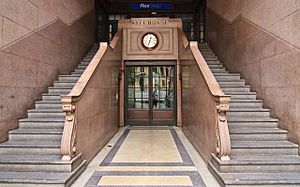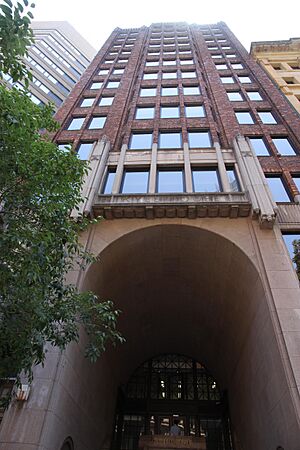Kyle House, Sydney facts for kids
Kyle House is a special old office building found at 27–31 Macquarie Place in the heart of Sydney central business district, New South Wales, Australia. It was designed by an architect named C. Bruce Dellit and built in 1931 by Stuart Bros. This building is owned by a private company. It was added to the New South Wales State Heritage Register on April 2, 1999, which means it's officially recognized as an important historical place.
Contents
History of Kyle House
Macquarie Place is a very important spot in New South Wales. An obelisk (a tall, pointed stone pillar) was put there by Governor Macquarie in 1818. This obelisk was the starting point for measuring all distances in the colony.
The land where Kyle House now stands was once owned by important early traders. One of them was Simeon Lord, who had a large sandstone mansion and a warehouse there. This property stayed in his family until 1920.
McArthur Shipping Company
From the 1890s, the property was leased to the McArthur Shipping Co. This company was started by Alexander McArthur, who came to Sydney around 1840. He built a huge business that sold goods all over Australia and even had a head office in London.
In 1929, the McArthur Shipping and Agency Co Ltd bought the Sydney property. They hired a talented young architect, C. Bruce Dellit, to design a new building. Lord's old mansion was taken down, and Kyle House opened in late 1931. Stuart Bros built the new structure.
McArthur Shipping was the main company in Kyle House, but many other businesses also rented offices there, including Dellit himself. After some big changes inside the building in 1983, McArthur sold Kyle House to another company.
What Kyle House Looks Like
Kyle House is built with strong materials like precast concrete panels, face brick, and rendered masonry. It has windows with steel and aluminum frames.
Building Condition
The upper floors of Kyle House stick out over the back courtyard. The building is generally in good condition, meaning it's well-maintained.
Why Kyle House is Special
Kyle House is important for many reasons, especially because of its history and unique design. It's listed on the New South Wales State Heritage Register because it meets several important criteria.
Historical Importance
The land where Kyle House stands has been a center for major businesses since the 1700s. Two big companies, Lord's and McArthur's, had their main operations here. The building's location near the Tank Stream (an important early water source) is also significant.
Kyle House shows how important shipping and trading were as the colony of New South Wales grew. Its location near Circular Quay and the Royal Exchange Building made it a key spot for merchants and bankers.
Architectural Design
Kyle House is a great example of the Inter-war Art Deco style. This style focuses on tall, vertical lines and detailed decorations. It was one of the first buildings in Sydney to move away from older styles. It tried to find new looks that fit the 20th century.
The architect, C. Bruce Dellit, was very talented but died young. Kyle House is one of only two office buildings he designed in his private practice. It shows his skill and how he used new building materials for the time.
The huge arch on the ground floor is very noticeable. Kyle House also helps make Macquarie Place a historic and interesting street.
Community Connection
Kyle House has always been a place for businesses since it was built in 1931. It shows how the city's harbor and trade activities have always been important in this area.
Unique Features
Kyle House is rare because it's one of the few remaining Art Deco office buildings in Sydney's city center. Its front (façade) has mostly stayed the same since it was built in 1931.
The courtyard and access way at the back of Kyle House are also quite rare today. They remind us of how the area was used for shipping and trading in the early 1800s.
Kyle House also shows how building heights were limited by city rules at the time. It used an early form of "cantilevered" concrete, which means parts of the building stick out without support from below. This showed the new possibilities of concrete.



